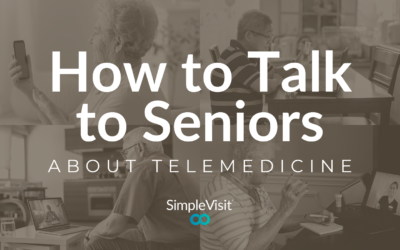Industry Leaders Push for Permanency for Telehealth Coverage Expansions
Allie Clark | 8 min read | June 8, 2020
During the COVID-19 pandemic, telehealth has been necessary for not only the health of all American citizens, but also that of healthcare companies of all sizes. Virtually delivered services have kept many medical offices open that might have otherwise gone under, and that has largely been due to relaxation of both state and federal regulations and the expansion of reimbursement for remote care.
As the country starts to cross the threshold from shutdown to a new normal, however, the question on everyone’s mind is “What’s going to happen now?” In response, many industry stakeholders have started to speak out urging lawmakers to consider keeping at least some of the coverage and reimbursement changes for good.
United States House of Representatives
In a letter dated May 21, 2020, thirty members of the United States House of Representatives wrote to Nancy Pelosi, the Speaker of the House, and Mitch McConnell, the Senate Majority Leader, urging them to consider drawing out the current expanded benefits for behavioral health services. They ask for a transition period following the conclusion of the National Emergency so that data can be collected in a more normal healthcare setting on “which of those flexibilities should be continued permanently.” Citing the gap in access to care for these services, especially for those in vulnerable geographic and socioeconomic communities, they express concern over what a loss of the easy access this period of regulation relaxation has provided would mean for them. They close the letter stating: “Telehealth is proving to be a successful means in bridging this gap of care, and it is critical that once the COVID-19 pandemic subsides, access to behavioral health services does not.”
To access the original letter, go here.
To read mHealthIntelligence’s article on the letter, go here.
American Psychiatric Association
The President of the American Psychiatric Association (APA), Jeffrey Geller, spoke to Congressional staff and reporters in a video briefing on May 27, adding their voice to the call for these lifting of restrictions on telepsychiatry to be made permanent after the crisis subsides. Geller specifically referred to the geographic and location requirements that were lifted early on, but noted that the inclusion of audio-only services could also be very beneficial to psychiatrists moving forward. Also included in the requests was the permanent elimination of the rule that requires an initial in-person visit with a patient before they can be prescribed controlled substances, a portion of the Ryan Haight Act that was expected to be addressed by the DEA late last year but never was. He continued by underlining the value of telemedicine to the field of psychiatry in particular, stating that, “psychiatric care provided by telehealth is as effective as in-person psychiatric services,” and that “some patients prefer telepsychiatry because of its convenience and as a means of reducing stigma associated with seeking help for mental health.” There were many receptive ears in his audience, including Rep. Paul Tonko (D-New York), who was one of the first signatures on the letter mentioned above.
To read the article from MedScape on the APA briefing, go here.
National Association for Home Care & Hospice
Hospice care providers are also lending their voice. The National Association for Home Care & Hospice (NAHC) sent a letter on May 15, 2020 to Seema Verma, CMS Administrator, starting the conversation about making the current guidelines permanent for hospice care. In this letter, they state that “roughly 98% of hospice care” is delivered in the patient’s place of residence. These services have not only been easily replaced by remote care methodologies during this pandemic, they are some that could be enhanced and supported by continued telemedicine services in the future. NAHC President William A. Dombi details specific action items for the Administrator to pay attention to, and emphasizes that, while we don’t know when the pandemic will end, now is the time to start this work. He goes on the say: “Further, it may be time to set in motion actions that will allow for proper monitoring of utilization of technology-based visits and for assessment of their impact on quality of care outside of the current public health emergency.”
To read the letter, go here.
To read mHealthIntelligence’s analysis of the letter, go here.
College of Healthcare Information Management Executives
The College of Healthcare Information Management Executives (CHIME), an organization that represents “CIOs and other health IT leaders in patient care organizations nationwide,” joined the chorus on May 12, 2020. In their public statement, they cast a wide net, calling on Congress, the Trump Administration, CMS, and “all other insurers” to continue the work they have done to make telehealth accessible, affordable, and logistically realistic for providers during this crisis. Their concluding statement is echoed in the thoughts being expressed throughout the industry: “We cannot go back to pre-COVID telehealth; instead, we must go forward. Patients will demand it and providers will expect it. We encourage everyone in healthcare to build on the momentum and continue to innovate with virtual care. Working together, we will come out of this pandemic stronger, better, and more resilient than ever.”
To read the original statement from CHIME, go here.
To read the article from Healthcare Innovation on the statement, go here.
To learn more about how SimpleVisit can help you deliver the most user-friendly telemedicine service on the market, call our Sales Team at 877-83-VISIT or fill out our Buyer’s Guide form.
How to Talk to Seniors (About Telemedicine)
Allie Clark | 10 min read | November 13, 2020In the midst of an unprecedented healthcare crisis, it’s important to be mindful of some of the most vulnerable members in our communities: our seniors. This particular season has been uniquely challenging for older...
The Journey Through
Allie Clark | 10 min read | October 28, 2020The lingering uncertainty of the pandemic in America is causing consumers and practitioners to adjust and re-adjust expectations for healthcare delivery. Regulators are changing their stance on privacy and coverage...
How to Launch a Successful Telemedicine Program
Rob Warlick | 5 min read | October 13, 2020Telemedicine has moved beyond intriguing to imperative in a short amount of time. Medical groups across the country are faced with the challenge to build and maintain a successful telemedicine program simply to retain their...



